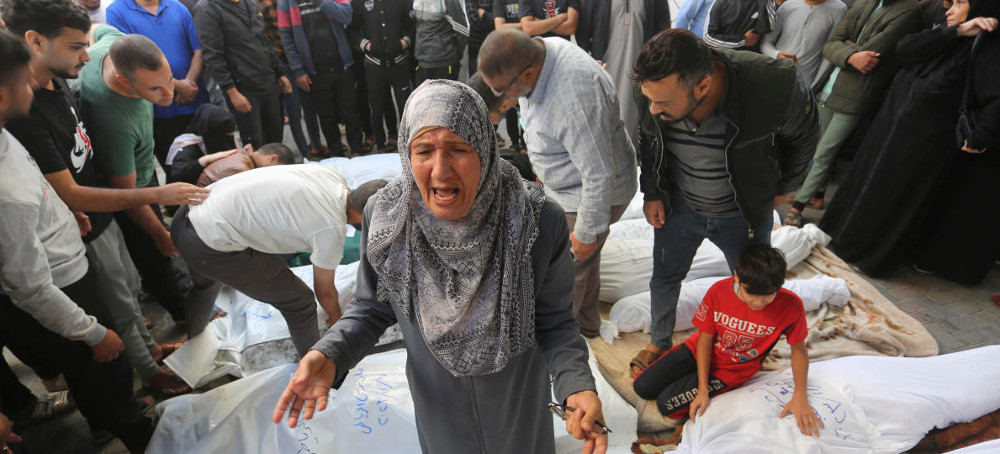Washington Post Cartoon Slammed as 'Racist, Vile,' Ignites Controversy
Al Jazeera Palestinians mourn their relatives killed in the Israeli bombardment of the Gaza Strip in Rafah, November 7. (photo: AP)
Palestinians mourn their relatives killed in the Israeli bombardment of the Gaza Strip in Rafah, November 7. (photo: AP)
Publication takes down Hamas drawing by Michael Ramirez after it was criticised as dehumanising towards Palestinians
Titled, Human Shields, it depicts a man in a dark, striped suit, which has Hamas in bold white letters emblazoned on it, for the Palestinian group.
The man’s eyebrows are arched, his nose is comically large. He has four children strapped to his body, including a baby positioned on his head. A woman – veiled and docile – and meant to represent Palestinian women, cowers behind him.
The man is lifting a finger and the thought cloud above him reads: “How dare Israel attack civilians …”. According to the cartoon, published on November 6, he is Hamas.
The title as well as the depiction of children and a woman tied to him, appear to reference allegations by Israel, which are often repeated by Western leaders and echoed by many mainstream media outlets, that Hamas uses human shields.
Next to the man, woman and children, who are flanked by a Palestinian flag, is a partial portrait of the Dome of the Rock in occupied East Jerusalem and beneath is an oil lamp.
The cartoon was published as more than 10,000 Palestinians in the Gaza Strip, including 4,000 children, have been killed in Israeli military attacks since the war started on October 7.
Two days after publication, the outrage on social media, as well as the Washington Post’s website was growing. Late on Wednesday, the publication said it had taken down the drawing after it was criticised as racist and dehumanising toward Palestinians.
On X, formerly Twitter, a user called the image “beyond vile, bigoted and dehumanising”.
Others said the dehumanisation was reminiscent of anti-Semitic cartoons that depicted Jews in a negative light.
“I can’t get over how this looks exactly like a traditional antisemitic character, just with a few modified features”, posted one user, while another wrote: “Notably this is exactly how they used to depict Jews in European newspapers in the 1930s.”
On the Post’s website, one reader commented: “Shame on Washington Post for using racist tropes that are currently being used to justify a genocide where majority killed are children. Dehumanizing any peoples paves a way for injustices to occur. Unfortunate to see The Washington Post fuel that racist fire. This cartoon and the fact that it was published is appalling.”
After taking down the article, the Post published a series of letters and comments it had received from readers. Scholars, academics and civil society representatives voiced their concern that, as one reader wrote: “The essence of responsible journalism lies in its ability to give voice to those who might not have one, to champion transparency and to promote informed dialogue. When content is published that contradicts these principles, it raises legitimate questions about the editorial processes, integrity and reliability.”
Another reader, wrote: “I am a scholar of religion and media; I recognize a deeply racist depiction of the “heathen” and his barbarous cruelty toward women and children when I see it again in Michael Ramirez’s Nov. 8 editorial cartoon. It is in no way informative, helpful or thought-provoking to look at this conflict through the glasses of 19th-century colonialists.”
Many readers pointed to the irony that the cartoon implies that children are the victims of Hamas, yet it is actually Israeli bombs that are killing them. “Laying the deaths of Palestinian civilians at the feet of Hamas instead of the people actually killing them is a gross mischaracterization of the situation,” stated one letter.
The cartoonist, Michael Ramirez, a two-time Pulitzer Prize winner, has attacked Palestinians before. In another cartoon, he plays on the slogan “Black Lives Matter”, to make it “Terrorist Lives Matter”, implying that the support that Black people in the United States have shown for Palestinians is tantamount to siding with Hamas.



